Looking back at 2020, which changed everything we do in Somalia
WHO’s response to COVID-19 in Somalia was a year of resilience, impact and innovation. As Somalia marked one year since the first case of COVID-19 was laboratory-confirmed in Somalia, this photo story depicts the work of WHO in Somalia showcasing how the Organization supported the Government and its other health partners to save lives and protect the people in a very fragile, complex and vulnerable setting with determination, courage and commitment. The whole of WHO’s country office staff worked tirelessly respecting their duty of care to combat this epidemic. They were deployed throughout the country even in areas not easily accessible for responding to this greatest ever public health crisis in the history of Somalia. This photo story is a tribute and reflection of the work done by WHO country office in Somalia supporting the Government and other health partners in responding to the COVID-19 pandemic in 2020.
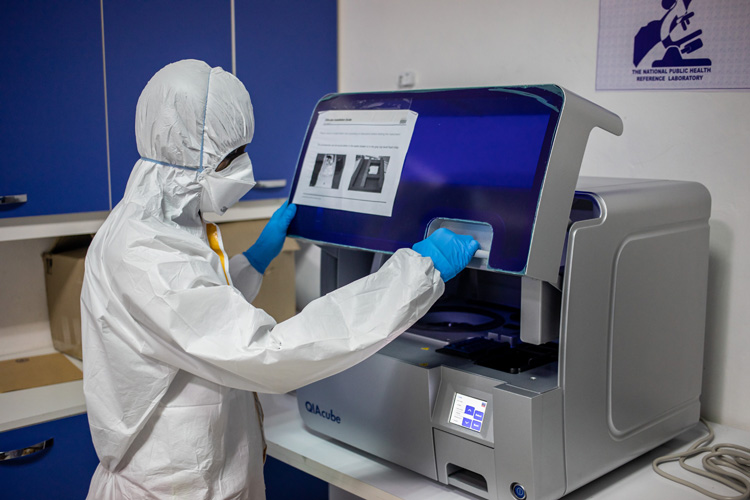
Detecting and testing for COVID-19: racing against time
In early 2020, when the country reported its first case of COVID-19, Somalia found itself in a race against time as the country did not have a single laboratory with the capacity to conduct any molecular test to diagnose cases. In a matter of weeks, WHO joined forces with Somalia’s Federal Ministry of Health and Human Services and other partners to procure, install and operationalize real-time reverse transcription polymerase chain reaction (RT-PCR) testing in 3 public health laboratories (in Mogadishu, Garowe and Hargeisa) to test for and identify COVID-19 virus – a critical need as part of WHO’s strategy to “test, trace, track and treat” COVID-19. This catalytic support of WHO encouraged other partners and the Government to set up 3 more laboratories with the capacity for real-time RT-PCR testing across the country. In addition, the capabilities of 21 tuberculosis detection centres were enhanced by providing testing cartridges for GeneXpert machines to enable them to test for COVID-19. WHO continues to support the 24 testing laboratories that have been set up across the country for COVID-19 with recurrent laboratory supplies such as PCR testing kits, reagents, sample collection kits, external quality assurance programme. During last year, with WHO’s continued operational, financial and technical support, the country tested over 135 000 samples (13 tests/1000 populations and 10–13 tests per one laboratory-confirmed case).
Tracing and tracking: linking community with health system
During last year, WHO deployed 3327 community health workers in 51 high-risk districts. They were at the heart of WHO’s strategy to test, trace, track and treat COVID-19 in Somalia, especially in remote locations that usually remain cut off owing to distance or security situations. These community health workers were a vital cog in the country’s surveillance and response system linking communities and health facilities by identifying suspected cases and referring them for testing and treatment. Trained by WHO, these workers have used their skills to detect and identify suspected cases by asking household members in the community about COVID-19 symptoms, and to communicate health knowledge on prevention and mitigation measures. During last year, these community health workers visited 4.4 million households in the country and detected about 43% of all the 9222 laboratory-confirmed cases reported by the country at the end of 2020. During the same time, they have followed up 16244 individuals at their home as part of their contact tracing activities.
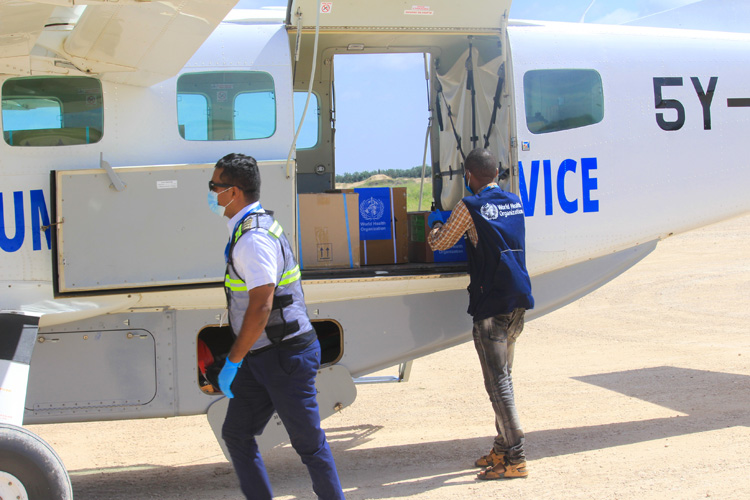
Shipping and transporting of samples: no deterrence despite inaccessibility
Owing to the geographic vastness of the country, poor road infrastructure and security concerns, transportation of COVID-19 samples from the remote locations to the testing laboratories were a real challenge. Timely testing and early diagnosis were important for case detection, contact tracing and “quarantine” of laboratory-confirmed cases to reduce transmission. WHO overcame this challenge by distributing COVID-19 sample collection to the remote and peripheral location and also arranging for their speedy shipment and transportation to the designated testing laboratory by deploying chartered flights, as well as using regular humanitarian flights operated by the UN Humanitarian Air Services (UNHAS). During 2020, WHO deployed 14 952 sample collection kits in areas that are not easily accessible and also supported financially to ship 5000 samples using chartered or regular flights from these areas to the designated laboratories.
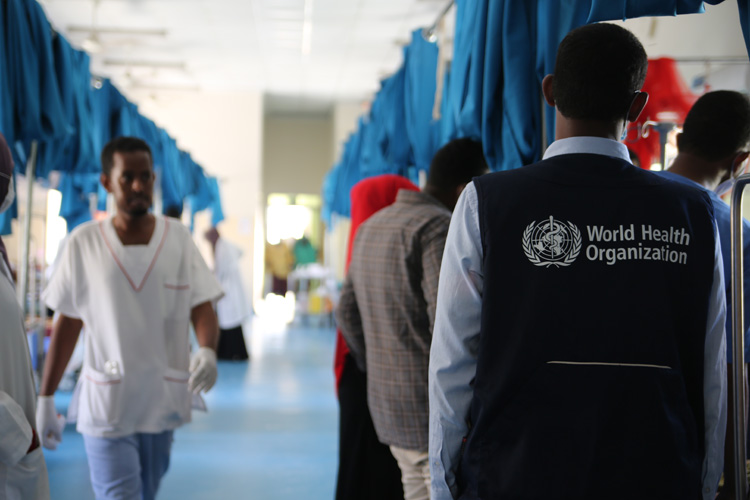
Treating for COVID-19: equipping treatment centres with oxygen
When the first laboratory-confirmed case of COVID-19 was reported in Somalia in March 2020 and the outbreak was spreading rapidly across the country, there were no functioning treatment centres in the country specialized for the treatment of COVID-19, and none of the public sector hospitals in Somalia had medical oxygen available. WHO Somalia worked with the country’s health authorities and partners to ensure functional COVID-19 treatment centres were put in place throughout the country. WHO supported the establishment of 19 such treatment centres and equipped them with supplies to protect health care workers and treat COVID-19 patients, including providing 68 medical oxygen concentrators, refillable oxygen cylinders and non-invasive ventilators. WHO also trained over 8571 health care workers on COVID-19 treatment and case management. As of March 2021, 1320 patients with COVID-19 had received treatment from these centres. WHO also supported the operational cost of these centres to ensure they functioned effectively.
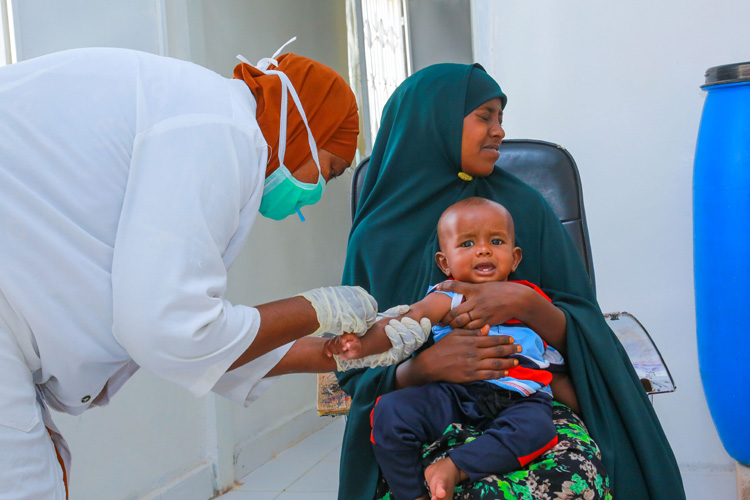
Maintaining essential health services: protecting the precious health gains
The COVID-19 pandemic severely strained the fragile health system in Somalia. The lockdown and the social distancing measures imposed to contain the virus also raised fear among health care workers about providing other routine essential health care, such as immunization for children, care of pregnant and lactating women, as well as care for malnourished children. As a result, the COVID-19 pandemic potentially risked reversing some health gains. The WHO country office, in partnership with UNICEF, United Nations Family Planning Association and other partners augmented essential health care services, which allowed immunization services, essential newborn care, care for pregnant and lactating women and other routine primary health care services to resume normally in the midst of the pandemic. While the outbreak was unfolding, WHO’s efforts in maintaining essential health services protected 407 956 children from 6 months to 5 years against measles, 459 456 children under 5 years from polio through conducting an integrated campaign in the midst of the pandemic. 99 085 people living in 20 489 households were protected against malaria by indoor residual spraying, In June 2020, mass drug administration against schistosomiasis, conducted together with deworming, protected about 3.18 million people (2.78 million children and 0.4 million adults) and WHO and UNICEF supported health authorities to distribute almost 1.3 million long-lasting insecticidal nets to households, which contributed to protecting of an estimate 2.6 million people.
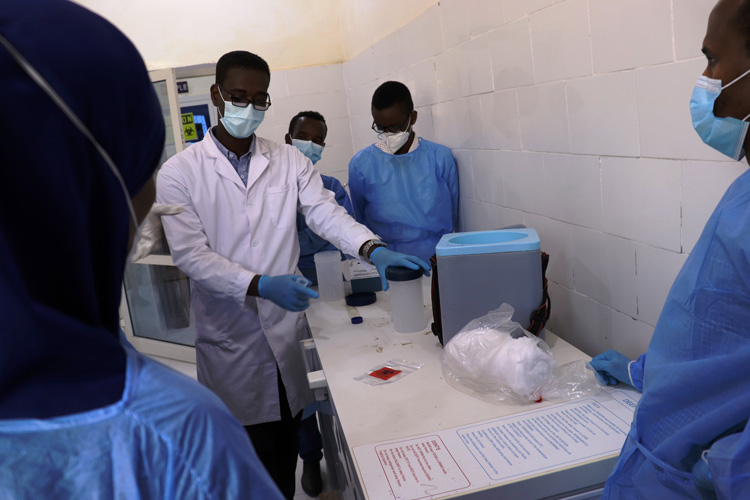
Translating knowledge into action: influencing evidence-informed policies
A key COVID-19 lesson was that context-specific health research, policies and practices are needed even in low-resource settings, not only to better understand the unknowns but to bridge knowledge gaps in such settings, which can contribute to the global public good by providing evidence on what works better in such settings and improve context-informed responses. The use of evidence from fragile countries such as Somalia to guide appropriate policy will go a long way to influence decisions that will contribute to improved health outcomes, realization of universal health coverage (UHC) and achievement of the Sustainable Development Goals. The WHO country office in Somalia, in collaboration with the health ministries, other international agencies and national and international academic institutions has supported 9 research studies during 2020 as part of its response to COVID-19. Out of these research activities 2 manuscripts were published in peer-reviewed medical journals and 3 policy briefs were also published to influence appropriate policy setting on the basis of these research findings.
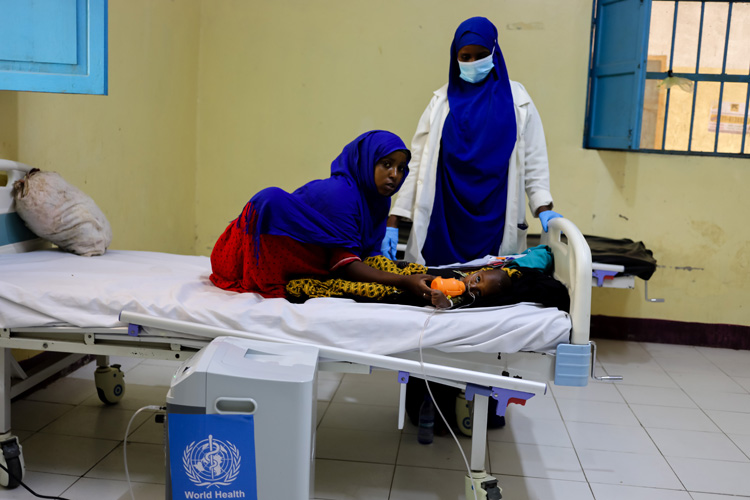
Driving innovation: using solar powered oxygen concentrators to save lives
When the first laboratory-confirmed case of COVID-19 was reported on 16 March 2020 in Somalia and the outbreak was raging across the country, none of the public sector hospitals in Somalia had medical oxygen available. Driven by the dire need for pure, high-grade medical oxygen, WHO country office developed a road map for bridging medical oxygen access gaps in the country. As part of this road map, the WHO country office installed the solar-powered oxygen concentrators in the Hanaano General Hospital, Dusamareb in Galmudug State, early in February 2021, which is the first of such innovation in the country. WHO collaborated with Grand Challenge Canada (GCC), one of the innovation funders on this intervention. This oxygen system which is solar powered and operates 24/7 has helped patients suffering from birth asphyxia, pneumonia, COVID-19, major trauma (gunshots, road accidents), shock and comatose, cardiovascular problems such as cardiac failure, and asthma since installation. The majority, over 90% of the patients including children who received medical oxygen from this site since is installation in February 2020, survived. The implementation of this innovative solution is also coupled with research supported by the UNICEF/UNDP/World Bank/WHO Special Programme for Research and Training in Tropical Diseases (TDR) to gather evidence of the system’s feasibility, utilization, cost-effectiveness and survival in a complex context like Somalia.
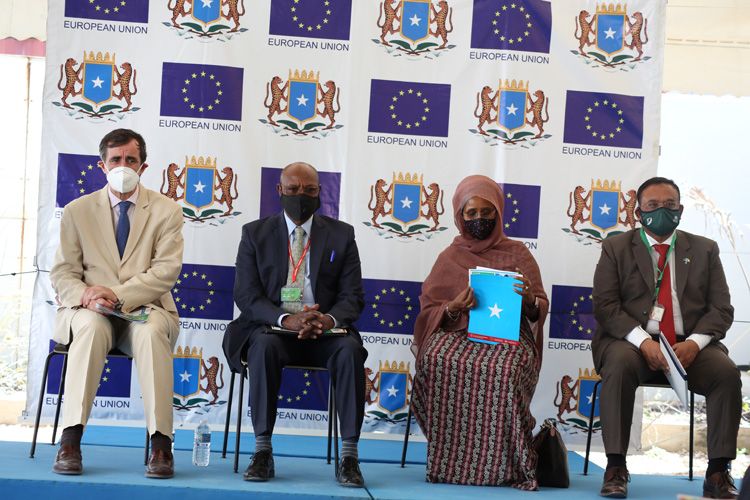
Engaging donors: building and strengthening partnerships
WHO actively reached out to its traditional and non-traditional donors for resource mobilization to support its strategic preparedness and response plan. Timely support from and continued collaboration with donors, including through regular participation of WHO in the Somali Health Donor Group, have remained the foundation of WHO Somalia’s efforts to respond efficiently and effectively to COVID-19. Between March 2020 and March 2021, contributions from donors amounted to about US$ 23.4 million, which allowed WHO Somalia to work with health authorities and other partners to control, limit and contain the spread and impact of COVID-19 in Somalia. During 2020, WHO also signed 14 financial and one non-financial donor agreement to support WHO’s covid-19 response work in Somalia.
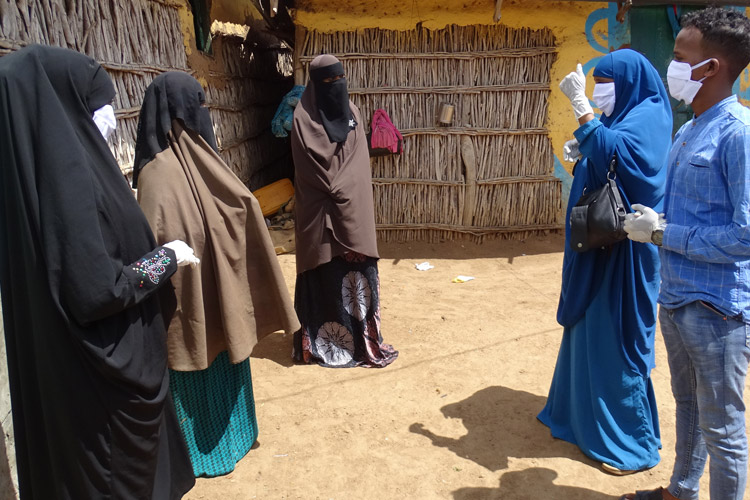
Informing risk: using social media for effective communication
Risk communication, in its different forms, has been a priority component of WHO’s response to the COVID-19 outbreak in Somalia. Risk communication, in its different forms, were used to mitigate the effect using from one-on-one awareness raising session on COVID through community health care workers, to radio broadcast, and posting of technical messages on social media. Over the last year, health messages on prevention and mitigation of risk from COVID-19 were delivered to 4.4 million households through house-to-house visits, 53 joint situation reports were published by WHO and the Federal Ministry of Health and Human Services 35 short risk communication videos were produced for social media and 355 tweets on risk communication messages were posted with over 2 million impressions.
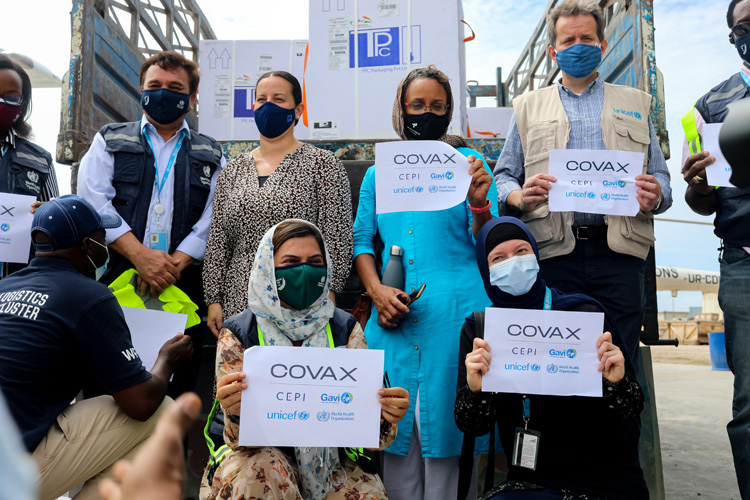
Recovering from pandemic: growing optimism and hopes
As the country shows signs of recovery from the effects of one of the worst ever public health crisis and turns the tide against COVID-19, WHO and UNICEF supported the Government to secure 1.2 million doses of the Oxford-Astra-Zeneca vaccine to vaccinate frontline workers, the elderly population and people with chronic health conditions, who comprise 3% of the population. In phases, the country is expected to receive additional vaccines to cover 20% of its population. On 15 March 2021, the day of one year of COVID-19 in Somalia, the country received 300 000 doses of the Oxford-Astra Zeneca vaccine, supplied by the COVAX Facility, as part of a first phase to protect frontline workers and elderly people with chronic health conditions. The country rolled out the COVID-19 vaccines on 16 March as optimism grew that ending the outbreak in the country is now possible.








